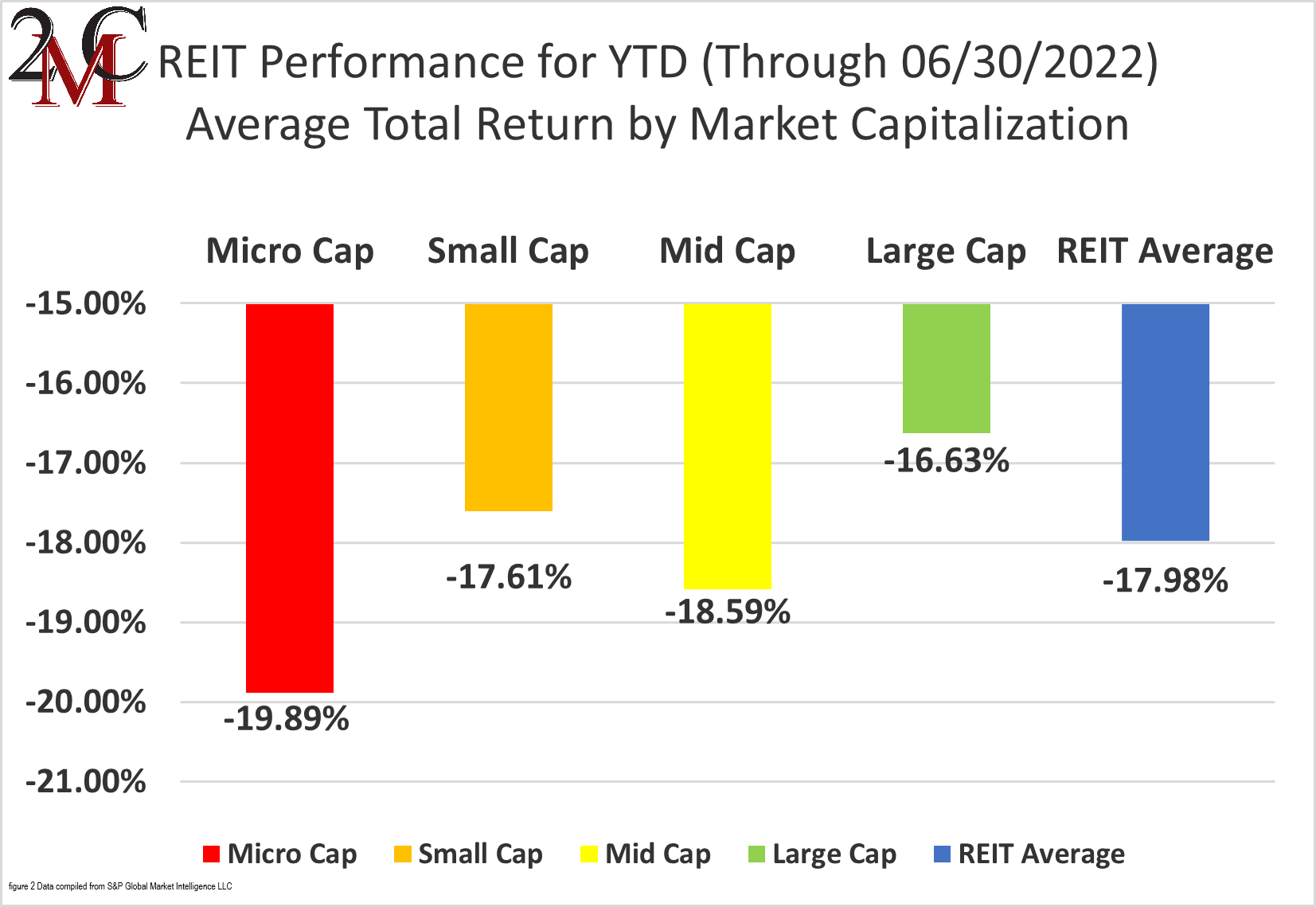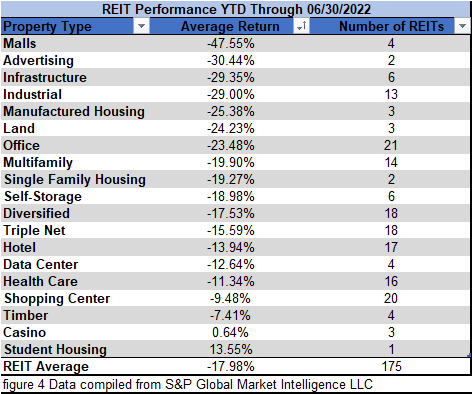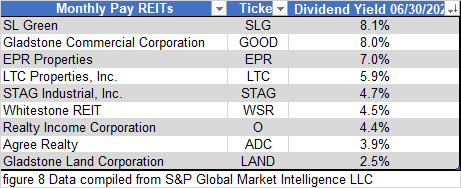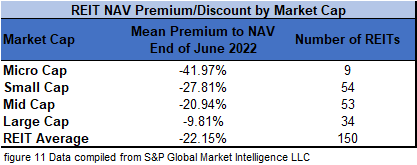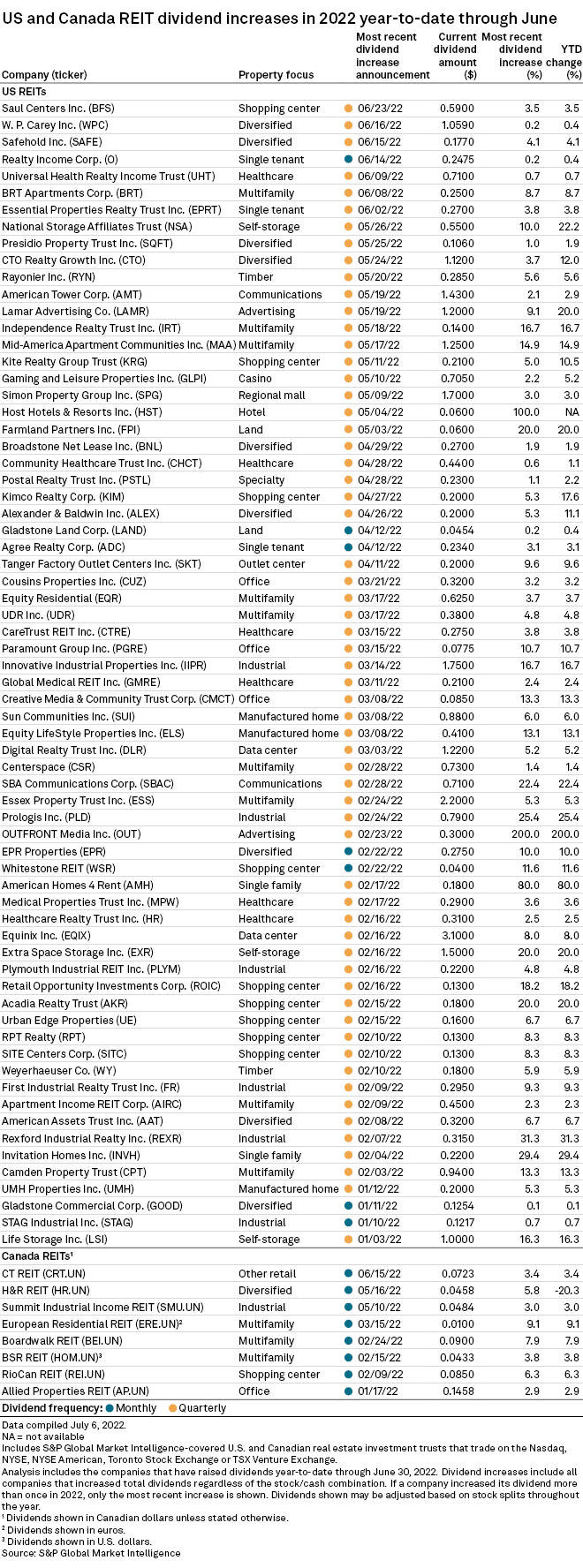The State of REITs: July 2022 Edition
- The REIT sector has fallen in 5 of the first 6 months of 2022, including a -9.44% total return in June.
- Large-cap (-7.01%) and micro-cap (-9.27%) REITs outperformed, while mid-caps (-9.66%) and small caps (-10.61%) suffered the heaviest losses in June.
- Only 10.0% of REIT securities had a positive total return in June.
- Student Housing (-0.82%) and Casino REITs (-1.41%) led all property types in June. Mall (-27.53%) and Land (-15.25%) REITs underperformed.
- The average REIT NAV discount widened from -15.59% to -22.15% during June. The median NAV discount also widened from -14.82% to -21.32%.
REIT Performance
The REIT sector extended 2022 losses with another rough month as REITs averaged a -9.44% total return in June. REITs underperformed the Dow Jones Industrial Average (-6.71%), the S&P 500 (-8.39%), and the NASDAQ (-8.71%). The market cap weighted Vanguard Real Estate ETF (VNQ) saw smaller losses than the average REIT in June (-7.46% vs. -9.44%) but remains deeper in the red YTD (-20.54% vs. -17.98%). The spread between the 2022 FFO multiples of large-cap REITs (19.4x) and small-cap REITs (14.4x) narrowed slightly in June as multiples decreased by 1.5 turns for large caps and 1.4 turns for small caps. In this monthly publication, I will provide REIT data on numerous metrics to help readers identify which property types and individual securities currently offer the best opportunities to achieve their investment goals.
Large-cap (-7.01%) and micro-cap (-9.27%) and mid-cap REITs (-9.66%) saw single-digit negative returns in June. Small cap REITs (-10.61%) underperformed and averaged double-digit declines. Large cap REITs (-16.63%) are outperforming small caps (-17.61%) by 98 basis points on YTD 2022 total return.
0 out of 19 Property Types Yielded Positive Total Returns in June
100 percent of REIT property types averaged a negative total return in June, with a 26.71% total return spread between the best and worst performing property types. Mall (-27.53%) and Land (-15.25%) REITs had the worst average total returns in June. Performance YTD within Land REITs has varied greatly. Safehold (SAFE), which started the year at a 44.61x FFO multiple, had a dismal -55.35% total return over the first 6 months of 2022 and now trades at a 19.3x multiple. Farmland Partners (FPI), which started the year at a 33.5x multiple has defied the selloff and achieved a +16.41% return YTD and now trades at a remarkable 48.14x multiple.
Student Housing (-0.82%) and Casino (-1.41%) REITs led all property types in June as all other property types were hit harder by the market selloff. Over the first half of the year, Student Housing (+13.55%) and Casino (+0.64%) REITs were the property types in positive territory.
Student Housing (+13.55%) and Casino REITs (+0.64%) are the top performing property types over the first half of the year. Malls (-47.55%) and Advertising (-30.44%) REITs are the worst performing property types thus far in 2022. All 4 Mall REITs are deep in the red in 2022, ranging from CBL Properties (CBL) at -24.71% to Pennsylvania REIT (PEI) at -78.10%.
The REIT sector as a whole saw the average P/FFO (2022) decrease 1.2 turns in June (from 16.6x down to 15.4x). The average FFO multiples rose for 5% and declined for 95% of property types in June. There are no recent 2022 FFO/share estimates for either of the Advertising REITs. Land (32.1x), Student Housing (26.1x), Industrial (22.9x) and Data Center (22.8x) currently trade at the highest multiples of any REIT property type. Mall (4.5x), Hotel (8.3x) and Office (9x) REITs are the only property types currently trading at a single-digit multiple.
Performance of Individual Securities
Preferred Apartments Communities (APTS) was acquired on June 23rd by Blackstone’s (BX) REIT (often referred to as BREIT). APTS shareholders received $25/share in this all-cash purchase.
InnSuites Hospitality Trust’s (IHT) (+38.46%) share price remained highly volatile in June, even though it was a period in which the REIT did not announce any significant news. Over the first half of 2022, IHT has seen positive returns in 3 months (ranging between +32.43% and +38.46%) and negative returns in 3 months (ranging between -17.05% and -22.19%), with no month seeing a price change smaller than 17%.
Pennsylvania REIT (PEI) (-51.45%) continues to freefall due to balance sheet concerns. PEI is selling off assets to stay current on interest payments and reduce debt, but the dispositions are taking longer than initially projected and the debt reduction thus far has been a tiny fraction of total debt. PEI is already down -78.1% YTD and on June 16th, PEI executed a 1-for-15 reverse stock split to regain compliance with NYSE standards pertaining to minimum share price.
Only 10.00% of REITs had a positive return in June with only 16.00% in the black year to date. During the first half of last year, the average REIT had a +25.92% return, whereas this year the average REIT has seen a -17.98% decline.

Dividend Yield
Dividend yield is an important component of a REIT’s total return. The particularly high dividend yields of the REIT sector are, for many investors, the primary reason for investment in this sector. As many REITs are currently trading at share prices well below their NAV, yields are currently quite high for many REITs within the sector. Although a particularly high yield for a REIT may sometimes reflect a disproportionately high risk, there exist opportunities in some cases to capitalize on dividend yields that are sufficiently attractive to justify the underlying risks of the investment. I have included below a table ranking equity REITs from highest dividend yield (as of 06/30/2022) to lowest dividend yield.

Although a REIT’s decision regarding whether to pay a quarterly dividend or a monthly dividend does not reflect on the quality of the company’s fundamentals or operations, a monthly dividend allows for a smoother cash flow to the investor. Below is a list of equity REITs that pay monthly dividends ranked from highest yield to lowest yield.
REIT Premium/Discount to NAV by Property Type
Below is a downloadable data table, which ranks REITs within each property type from the largest discount to the largest premium to NAV. The consensus NAV used for this table is the average of analyst NAV estimates for each REIT. Both the NAV and the share price will change over time, so I will continue to include this table in upcoming issues of The State of REITs with updated consensus NAV estimates for each REIT for which such an estimate is available.

Takeaway
The large cap REIT premium (relative to small cap REITs) widened in June and investors are now paying on average about 35% more for each dollar of 2022 FFO/share to buy large cap REITs than small cap REITs (19.4x/14.4x – 1 = 34.7%). As can be seen in the table below, there is presently a strong positive correlation between market cap and FFO multiple.
The table below shows the average premium/discount of REITs of each market cap bucket. This data, much like the data for price/FFO, shows a strong, positive correlation between market cap and Price/NAV. The average large-cap REIT (-9.81%) trades at a single-digit discount to NAV, while mid-cap REITs (-20.94%) and small-cap REITs (-27.81%) trade at double-digit discounts. Micro caps on average trade at less than 3/5 of their respective NAVs (-41.97%).
As share prices have continued to fall, REIT earnings have remained strong. One reason for this is continued tenant strength. Tenant bankruptcies can be very expensive for REIT landlords due to the rent loss of vacancy, so REIT investors should closely watch bankruptcy data for signs of economic trouble that could directly impact REITs. Although the number of US bankruptcies increased month over month in June, the 185 bankruptcies in the first half of 2022 is the fewest in the first half of a year in the past dozen years.
Market selloffs can be a painful experience for investors who are long stocks (and most other asset classes). One thing that can soften this blow and create opportunity is dividends. As long as the stocks in a portfolio continue to pay dividends during the market downturn, an investor continues to have positive cash flow even as asset values decline. This creates opportunity because this dividend cash flow can be used to purchase additional shares at reduced prices (thanks to the selloff). If these dividends are reinvested into stocks that pay a dividend, then portfolio income can continue to grow even during the selloff.
Another potential source of portfolio income growth is dividend hikes. 7 REITs raised their dividend in June: BRT Apartments (BRT) by 8.7%, Safehold (SAFE) by 4.1%, Essential Properties Realty Trust (EPRT) by 3.8%, Saul Centers (BFS) by 3.5%, Universal Health Realty Income Trust (UHT) by 0.7%, Realty Income (O) by 0.2% and W.P. Carey (WPC) by 0.2%. This was the 2nd dividend hike so far this year for O and WPC. If REIT earnings remain strong in the 2nd half of the year, the REIT sector will likely remain a great source of dividend growth.
Important Notes and Disclosure
All articles are published and provided as an information source for investors capable of making their own investment decisions. None of the information offered should be construed to be advice or a recommendation that any particular security, portfolio of securities, transaction, or investment strategy is suitable for any specific person. The information offered is impersonal and not tailored to the investment needs of any specific person.
We cannot determine whether the content of any article or recommendation is appropriate for any specific person. Readers should contact their financial professional to discuss the suitability of any of the strategies or holdings before implementation in their portfolio. Research and information are provided for informational purposes only and are not intended for trading purposes. NEVER make an investment decision based solely on the information provided in our articles.
We may hold, purchase, or sell positions in securities mentioned in our articles and will not disclose this information to subscribers, nor the time the positions in the securities were acquired. We may liquidate shares in profiled companies at any time without notice. We may also take positions inconsistent with the information and views expressed on our website.
We routinely own and trade the same securities purchased or sold for advisory clients of 2MCAC. This circumstance is communicated to our clients on an ongoing basis. As fiduciaries, we prioritize our clients’ interests above those of our corporate and personal accounts to avoid conflict and adverse selection in trading these commonly held interests.
Past performance does not guarantee future results. Investing in publicly held securities is speculative and involves risk, including the possible loss of principal. Historical returns should not be used as the primary basis for investment decisions. Although the statements of fact and data in this report have been obtained from sources believed to be reliable, 2MCAC does not guarantee their accuracy and assumes no liability or responsibility for any omissions/errors
Commentary may contain forward-looking statements that are by definition uncertain. Actual results may differ materially from our forecasts or estimations, and 2MCAC and its affiliates cannot be held liable for the use of and reliance upon the opinions, estimates, forecasts, and findings in this article.
Through October 2021, The State of REITs was published exclusively on Seeking Alpha by Simon Bowler, Sector Analyst at 2nd Market Capital Services Corporation (2MCSC). Editions subsequent to October 2021 will be published on this website in addition to other platforms that may include Seeking Alpha. 2MCSC was formed in 1989 and provides investment research and consulting services to the financial services industry and the financial media. 2MCSC does not provide investment advice. 2MCSC is a separate entity but related under common ownership to 2nd Market Capital Advisory (2MCAC), a Wisconsin registered investment advisor. Simon Bowler is an investment advisor representative of 2MCAC. Any positive comments made by others should not be construed as an endorsement of the author's abilities to act as an investment advisor.
S&P disclosure: S&P Global Market Intelligence LLC. Contains copyrighted material distributed under license from S&P.


